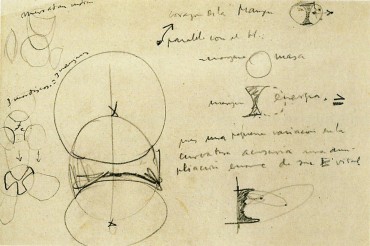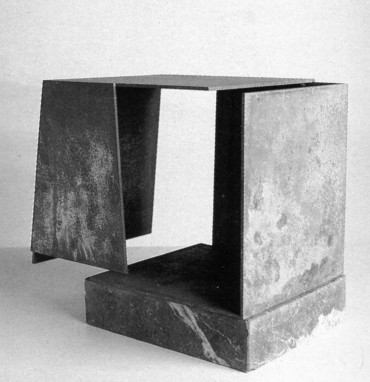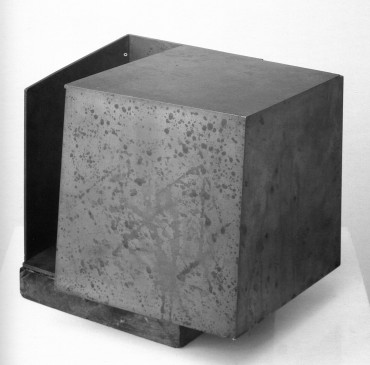
Jorge Oteiza, Sketch for hyperboloid (“apple / energy“), 1950

Jorge Oteiza, Metaphysical box by conjonction of two trihedrons, 1958-59

Jorge Oteiza, Portrait of the Holy Ghost, 1959
16.7.2014 – Issue 14 - Air – Concheiro Isabel – Essays
Jorge Oteiza: Void as Matter
by Isabel Concheiro
By definition, void and matter are complementary terms; the void is generated by the subtraction of matter and it is perceived in relationship to its opposite, a concrete or physical boundary. In the work of Jorge Oteiza the relationship between void and matter is reversed. His sculptural research is focused in the vacuum, but not in the vacuum in relationship to the mass, but in the vacuum as an active element, as a matter in itself: “Space is a place, and this place in which we develop and in which we attempt to make sculpture can be occupied or unoccupied. However an unoccupied place is not a vacuum. ... In physics, a vacuum is made, (otherwise) it does not exist. In aesthetics, it is similar. It is the result of a treatment or a definition of space that, through its formal emptying, receives its energy. An emptied space must not be confused with an empty space.” (1)
Oteiza is interested in the scientific concepts of fusion and space as an energy field generated from a particular arrangement of objects. He opposes the term fusion to subtraction as a way of emptying the space. The vacuum in what he calls the new energy statue or trans-statue is defined not by means of the physical emptying of a mass, but through the energy release produced by the fusion of light and dynamic units: “Hollowness must constitute the passage from a traditional mass-statue to the energy statue of the future; from the heavy and close statue to the open and lightweight statue. ... A sculpture in constant static expansion corresponds to a conception of the universe showing it as a phenomenon in constant expansion.” (2)
Besides its physical character, the vacuum in Oteiza‘s work is at the same time a metaphysical concept, a substitutes for religion and in that sense an expression of the Nothingness considered as spiritual fulfillment. The Negatio Negationis, the double denial of the mystics, is one of the most important influences in his work and implies a specific way of work through a series of successive eliminations, denials, to get to the essence, the vacuum, the Nothing: “Here the term negative refers to the procedure of acting creatively by successive negations, or a progressive series of eliminations, phenomenologically, reducing into brackets all that which we must put aside to isolate the true object of the action we pursue. This way we gain insight into the theology of the mystics, which achieves, by the way of a series of eliminations, of nothings, the final Nothing (in Saint John of the Cross) in which one enters into direct discovery and contact into communion, with God.“ (3) Thus, Oteiza‘s can be understood as a series of denials that conclude in an enlightened, energy filled vacuum: “Art is entering solitary a zone of silence. In this Nothingness man asserts his being.” (3)
(1) Juan Daniel Fullaondo, “Oteiza y Chillida”, La Gran Enciclopedia Vasca (Bilbao, 1976) pp. 21-22.
(2) Margit Rowell and Txomin Badiola (eds.), Oteiza: Propósito experimental (Madrid: Fundación Caja de Pensiones, 1988) p. 298.
(3) Jorge de Oteiza Enbil, Quousque Tandem ...! Ensayo de interpretación estética del alma vasca (Alzuza: Fundación Museo Jorge Oteiza, 2007) pp. 37-38.
Download article as PDF

